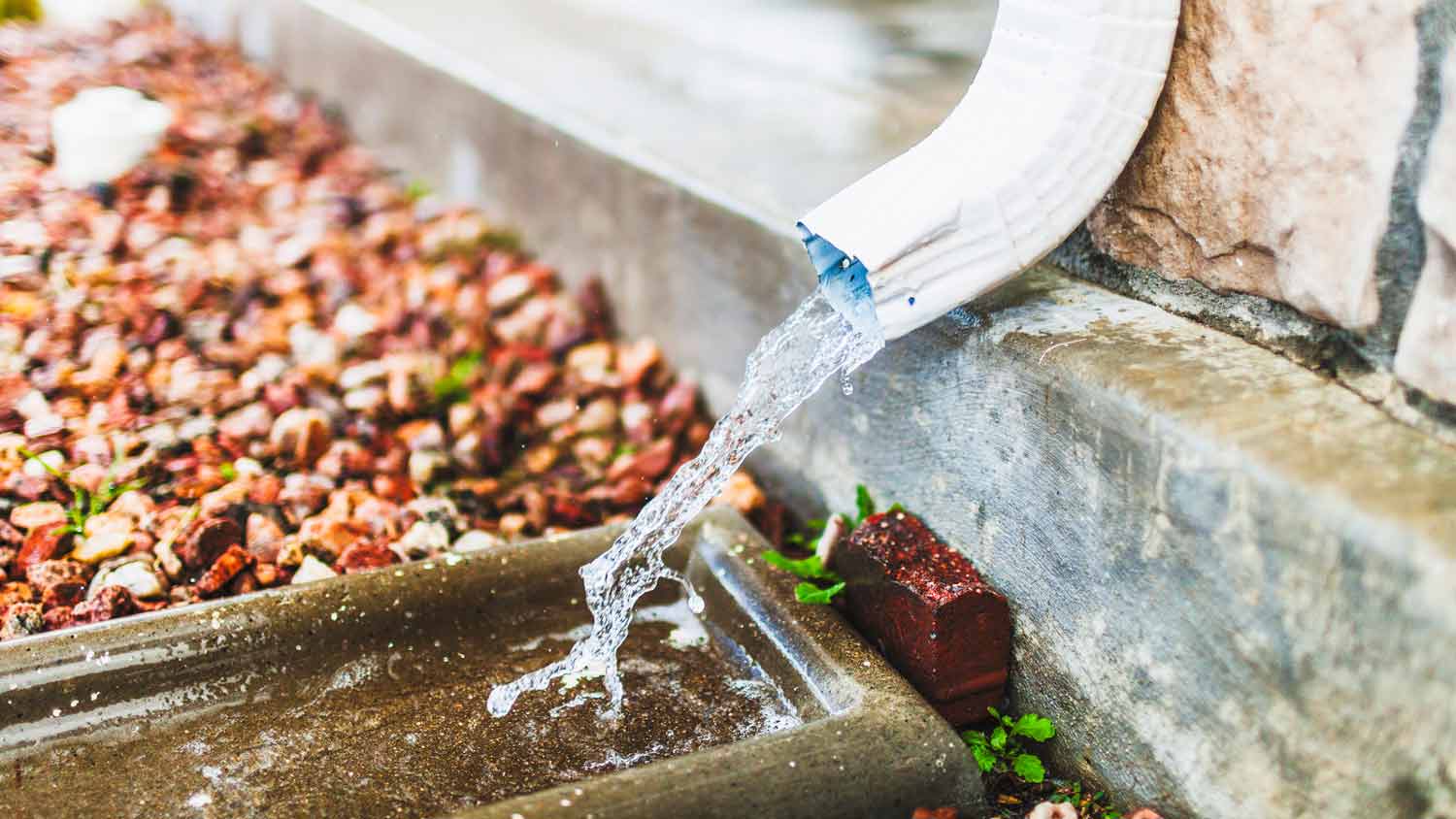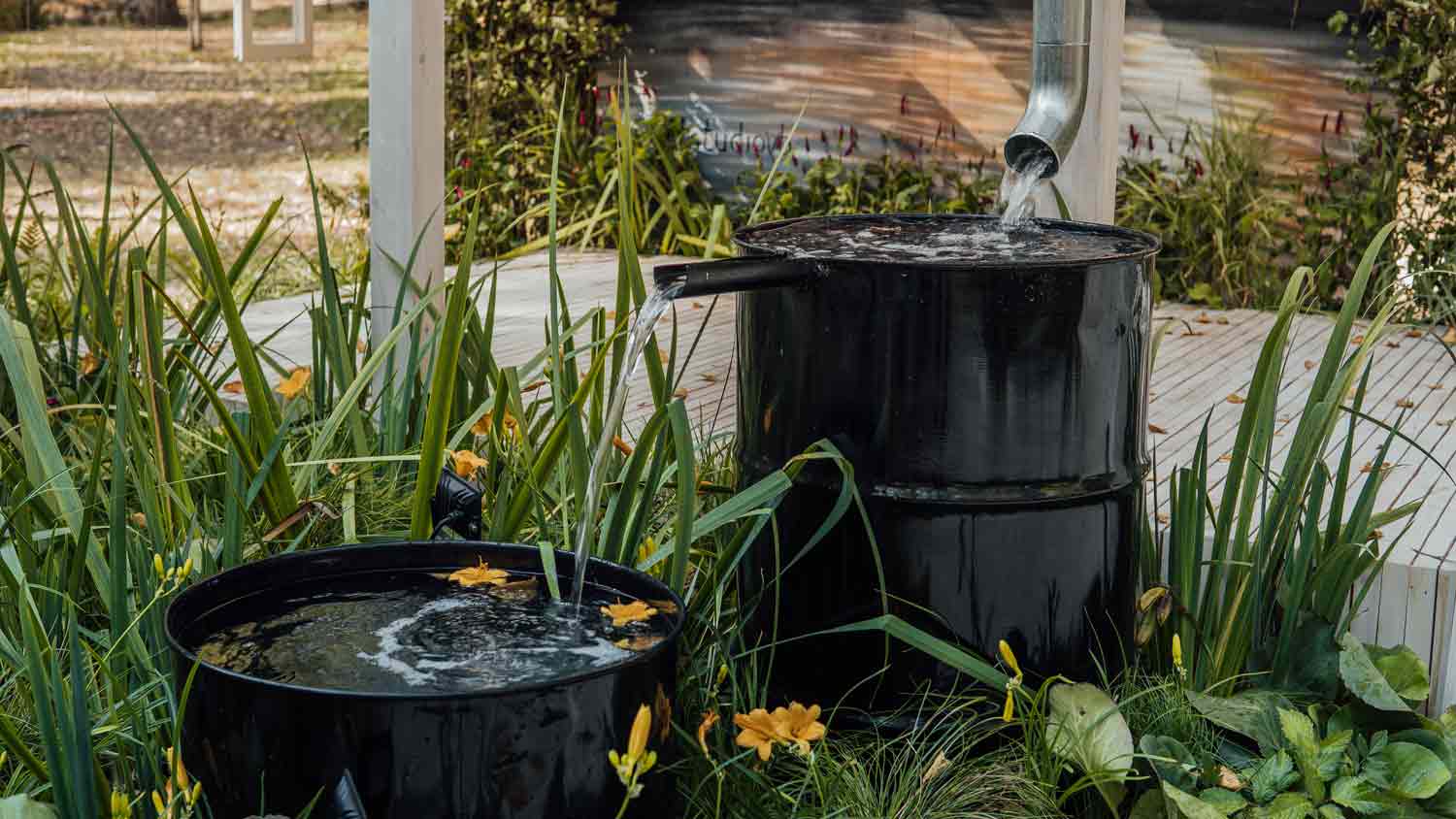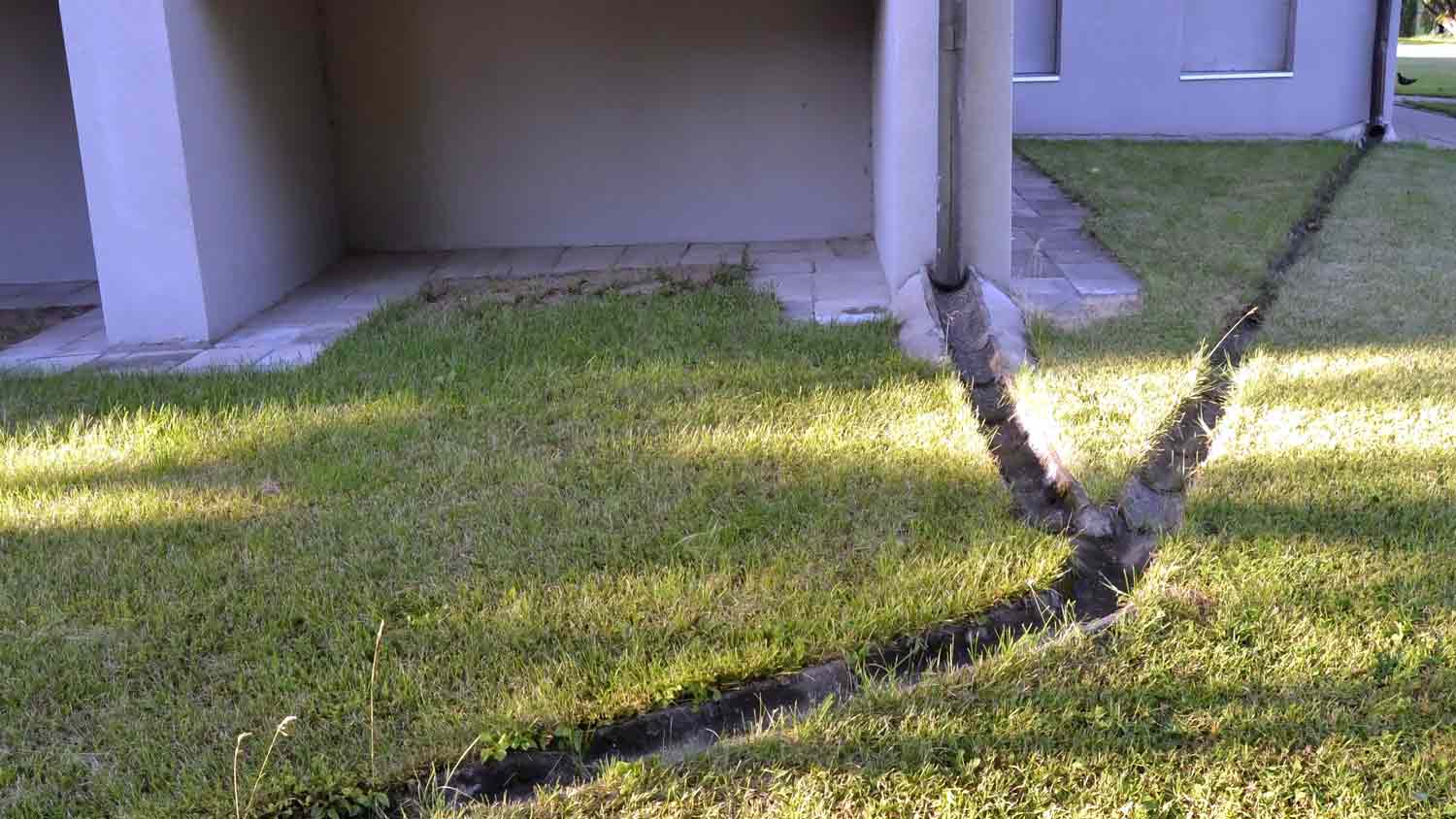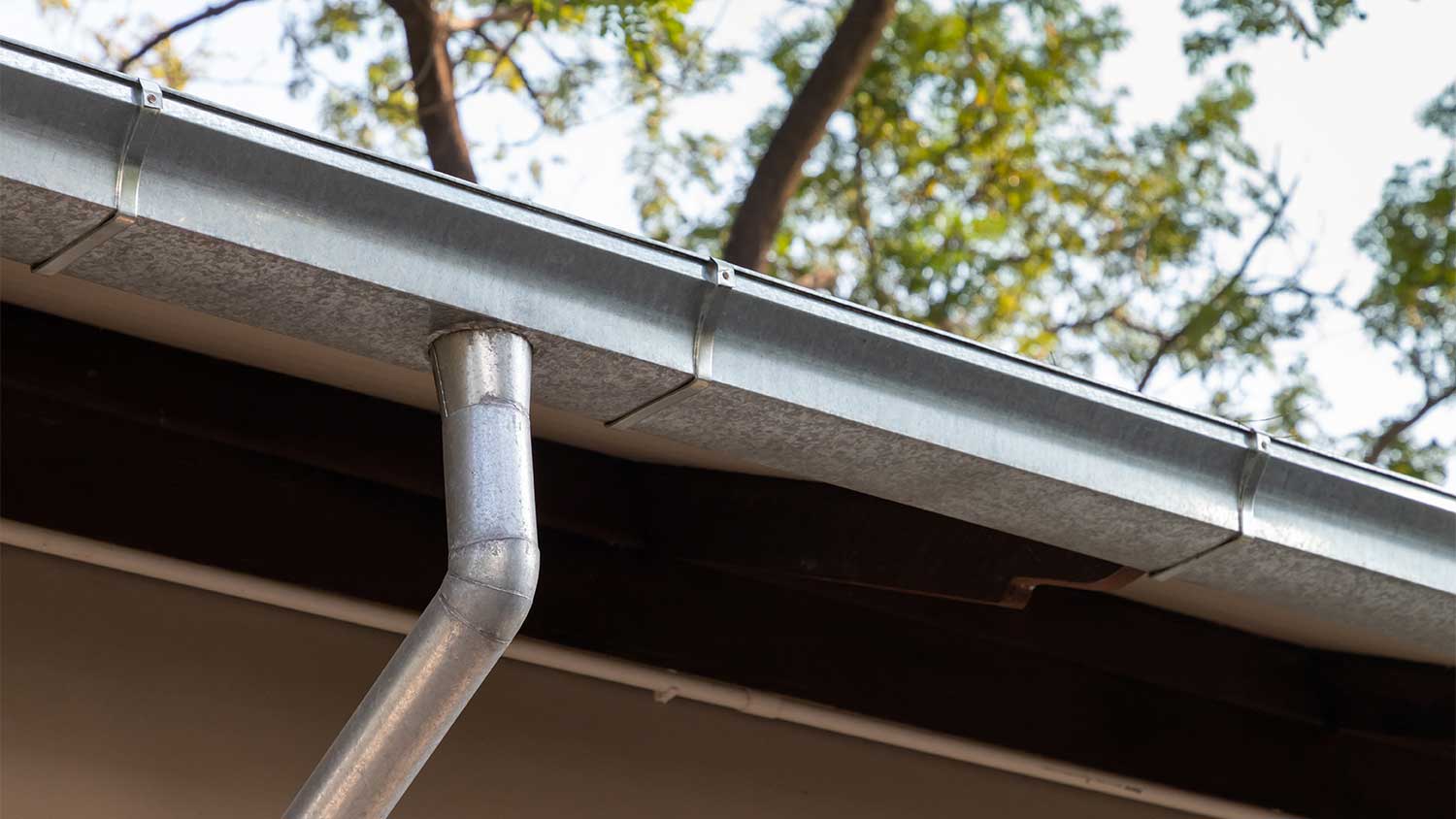
Here's everything you ever wanted to know about saving money by installing faux copper gutters instead of real copper gutters.
Don’t let rainy days stress you out


Improperly placed downspouts can allow excess water to saturate your home’s foundation, increasing the risk of cracks, settling, and costly structural repairs.
Hiring a handyperson costs $50 to $150 per hour, but it can be worth it to keep your property safe.
A professional can position your downspouts correctly to prevent soil erosion and property damage.
Pros arrive with proper safety gear, including safety glasses and gloves, which reduces the risk of injury while working with ladders, tools, and roofing components.
Homeowners may overlook key grading or runoff issues, but a gutter pro can identify problem areas and place downspouts in the safest and most effective locations.
If you find yourself chanting “rain, rain, go away” every time you see a dark cloud, you might be worried about how your home stands up against wet weather. While not everyone loves a rainy day, your home’s foundation is particularly vulnerable to too much rainwater. To help manage water flow from your gutter system, you need to divert downspout water effectively. Learn how to divert downspout water yourself in a few different ways.

Gutter downspouts are vertical pipes that transport rainwater from the gutters to the ground. This concentrated flow of water can cause major problems if it falls too close to your home. Properly diverting downspout water protects your home's foundation and prevents damage to your yard. Problems that can occur without enough room between your downspout flow and your home include:
Soil erosion: The concentrated force of water can erode the soil surrounding your foundation, weakening its structural integrity. Over time, this erosion can lead to cracks, settling, and even more serious structural issues.
Pest issues: Excessive water can saturate the ground around your foundation, creating a breeding ground for pests like termites and mosquitoes.
Flooding: Saturated soil can increase the risk of basement flooding, causing significant damage to your belongings and potentially compromising the structural stability of your home.
Damaged landscape: The forceful flow of water can wash away topsoil, depriving your plants of essential nutrients and leaving behind unsightly bare patches. It can also create muddy areas that can damage your walkways, patios, and driveway.

It's important that your gutter system's downspouts drain at least 5 to 10 feet away from the base of your house. Otherwise, water could collect near your home's foundation and cause significant damage.
Before you start any downspout drainage project, check with your local government about any rules or regulations regarding where you can discharge water from your property. You don't want to cause any problems for your neighbors by directing water onto their land.
When planning this project, you should also consider winter weather. It’s best to avoid directing water toward areas where it could freeze and create slippery or dangerous conditions, such as walkways or driveways.
If you are ready to divert your home’s downspout water, the good news is you have a few options to approach this project. When deciding which method is best for you, consider factors such as the amount of local rainfall, soil type, and the slope of your yard.
You can extend a downspout’s length by buying and installing a commercially available extension. Aim for an extension of at least five feet to effectively direct water away from your foundation. Downspout extensions come in various lengths and materials that make it easy to find the right fit for your home.

Another effective method for diverting downspout water is to install rain barrels. Rain barrels collect rainwater from your downspouts, significantly reducing the amount of water that needs to be diverted. The collected rainwater can then be used for various purposes such as watering plants, washing cars, or other non-potable uses.
Another option for diverting downspout water is creating a dry well. This involves excavating a deep hole about three to four feet deep and filling it with gravel or crushed stone. The downspout is then connected to the dry well, allowing the water to slowly percolate into the ground through the gravel.

French drains are a more complex but highly effective system for diverting water away from your foundation. This involves digging a trench along the foundation, placing a perforated pipe in the trench surrounded by gravel, and then connecting the downspout to the French drain. This system effectively collects and redirects water away from your foundation. However, it’s a complex project for typical DIYers—better to leave this one to a professional French drain installer near you.
Swales are shallow, gently sloping channels created in your yard to guide water away from your foundation. Planting water-loving plants along the swales helps to absorb and slow down the water flow from your downspouts.
Rain gardens are strategically designed depressions filled with native plants that absorb rainwater runoff from roofs, driveways, and patios. They not only reduce the amount of water entering storm drains but also create beautiful and environmentally beneficial features in your landscape.
Replacing traditional concrete or asphalt driveways and walkways with permeable materials like porous concrete or gravel allows rainwater to seep into the ground naturally, reducing runoff and replenishing groundwater supplies.
If you choose to DIY this project, these helpful tips can make it easier to divert downspout water safely and effectively from start to finish.
Assess your property: Before kicking off this project, evaluate your property's slope and amount of rainfall to determine the most suitable drainage solution.
Consider soil type: Different soil types have varying drainage capacities. Clay soils, for example, drain slower than sandy soils. Factor this into your drainage plan.
Plan and measure: Carefully plan the drainage route. Measure distances, slopes, and the volume of water you expect to handle.
Protect yourself: If you DIY this project, be sure to wear appropriate safety gear, such as gloves and safety glasses, while working.
Consider landscaping: Whenever possible, integrate your drainage solution with your landscaping design. Use plants to stabilize the soil around the drainage system and enhance the overall aesthetic.
Get a professional consultation: If you're unsure about any aspect of the project, consult with a professional gutter pro or landscaper. They can provide expert advice, assess your specific needs, and ensure proper installation—all while following the appropriate rules and regulations.
Clean your gutters: You should clean your gutters twice a year to make sure they don’t get clogged and cause water to overflow onto your foundation.
If you're handy and want to save money, you'll pay as little as $10 to $50 for a simple downspout extension you install yourself. However, if you need a more complex solution, such as a French drain, hiring a gutter professional near you is best. While you'll have to pay for labor, you won't have to worry about improper installation that could put your gutter system and foundation at risk.
Because the cost to work on downspouts varies based on the method, it helps to request quotes from a few pros to get the best deal.
Called to say he was running early, and we agreed on a new, earlier time. Showed him the leaks we had, and said we wanted an estimate for both repair and replacement. He said he would send us a quote, and, he went outside to check the roof and never returned. We expected him to come in and...
Very well repaired quickly!
They do a great job cleaning the gutters and come out promptly and are very reasonable.
They were suppose to do a garage tune-up and replace rollers. They replaced the rollers and noted how quiet they were and left. I was happy with that, but I am still unsure of what the first part was suppose to be.
The gutters were cleaned as expected, for the quoted price.
The work went great! Couldn't ask for better. Joel set a work start date. About the time of the storms that may have been associated with Sandy. He was half a day late. They set up on a Thursday. On Friday they had a full crew at work. By Monday they were finishing up. Now, the best...
The exhaust vent pipe to vent the furnace gas outside deteriorated and fell off. All knight replaced a "wye" connection and rehung the pipe. They were very responsive and met my schedule, and they were very mindful of my work/time commitments. The tech needed to run to the supplier to get the...
The service was very through and appeared to be very good. He did some things that repair people had never done before and patched leaks.
The cost is for installing the toilet. I bought the actual toilet. I have not received the bill for the replacement of the faucet yet.
From average costs to expert advice, get all the answers you need to get your job done.

Here's everything you ever wanted to know about saving money by installing faux copper gutters instead of real copper gutters.

This guide will give you an idea of how much you can expect to pay when getting new seamless gutters installed when accounting for removal, labor, and different gutter materials.

Gutter repair costs may not be as high as you think—but it depends on the type of damage you're addressing. Learn why you need to hire a gutter pro for this work.

Seamless gutters are a durable and low-maintenance solution for handling water drainage. Use this guide to learn all about whether seamless gutters are right for your home.

Discover galvanized steel gutters installation cost, including average prices, key cost factors, and tips to save on your gutter project.

Are you planning on installing gutters on your home? Before you get started, be prepared to discuss these gutter installation questions with your contractor.